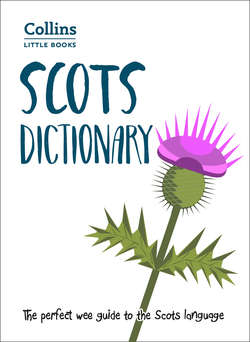Читать книгу Scots Dictionary: The perfect wee guide to the Scots language - Collins Dictionaries, Collins Dictionaries - Страница 6
ОглавлениеUsing this book
Headwords are shown in bold.
Variant Spellings. Modern Scots is more often spoken than written, and many words therefore have variant spellings based on the writer’s attempt to represent his or her pronunctiation of the word. The main entry for a word can be found at the spelling which we believe is most common in current use. We have tried to minimize the number of variants shown to make the text easier to follow, but where a number of spellings are in common use, the most common variant (or variants) is shown after the headword. For example:
cock-a-leekie or cockie-leekie Cock-a-leekie is soup made from a fowl boiled with leeks. Some recipes include prunes.
fae (fay) or frae (fray) Fae means from: some guy fae Tollcross; Where’d he get that fae?
The variant form is given an entry of its own, referring the reader to the main entry, unless the variant would come within five entries of the headword. Hence, there is an entry for frae but not one for cockieleekie:
frae (fray) A variant of fae.
Pronunciations are given for words which might be difficult or confusing for the non-Scots speaker. They are shown either by respelling, with the stressed syllable in bold, or by rhyming them with a word with a similar pronunciation.
ca’ or caa (caw) …
caber (rhymes with labour) …
ceilidh (kale-ee) …
There are a number of regional variations in pronunciation in Scotland: in general the form shown is a West Central Scotland one, that being the most widely spoken dialect, but where a word is most common in a particular area, the pronunciation appropriate to that region is given.
Where more than one way of pronouncing a word is in widespread use, all these pronunciations are shown.
dicht (diCHt or dite) …
In respellings, each syllable has been shown in a form likely to be clear to all speakers of British English. However, the following points should be noted:
g always represents the hard “g” in gun, never the soft “g” in gin
ch represents the “ch” in cheese or church
CH represents the guttural sound represented by the “ch” in the Scots loch and in the German composer Bach
th represents the unvoiced “th” in thin, three, or bath
TH represents the voiced “th” in this, father, or bathe
iy represents a vowel sound used in Scots but not in English. It is the vowel in the normal Scottish pronunciation of bite, pronounced a bit like “eye” but shorter. It is used in the Scots pronunciation of Fife and tide, as distinct from the longer vowel in Five and tied
wh: words which, in southern English, start “wh-” but are pronounced as if they started “w-” (for example, what, white) are always pronounced with an initial “wh” sound in Scots. This sound is rather like the “h” in hit and the “w” in wit pronounced almost simultaneously
